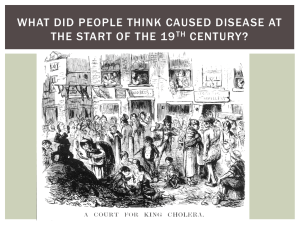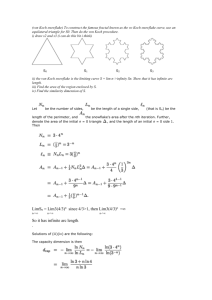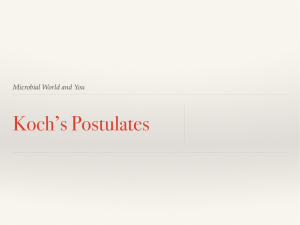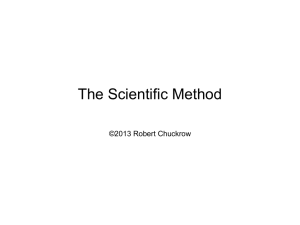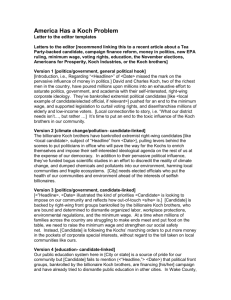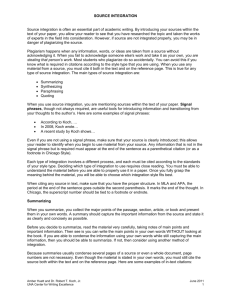Bauman Chapter 1 Answers to Critical Thinking Questions
advertisement
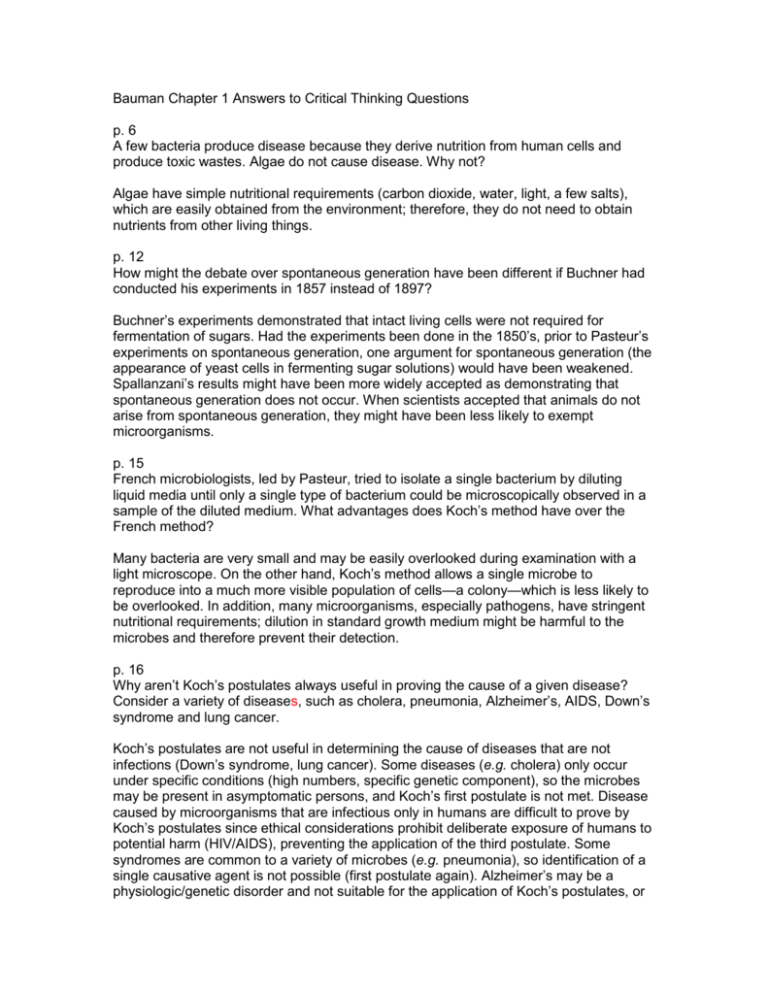
Bauman Chapter 1 Answers to Critical Thinking Questions p. 6 A few bacteria produce disease because they derive nutrition from human cells and produce toxic wastes. Algae do not cause disease. Why not? Algae have simple nutritional requirements (carbon dioxide, water, light, a few salts), which are easily obtained from the environment; therefore, they do not need to obtain nutrients from other living things. p. 12 How might the debate over spontaneous generation have been different if Buchner had conducted his experiments in 1857 instead of 1897? Buchner’s experiments demonstrated that intact living cells were not required for fermentation of sugars. Had the experiments been done in the 1850’s, prior to Pasteur’s experiments on spontaneous generation, one argument for spontaneous generation (the appearance of yeast cells in fermenting sugar solutions) would have been weakened. Spallanzani’s results might have been more widely accepted as demonstrating that spontaneous generation does not occur. When scientists accepted that animals do not arise from spontaneous generation, they might have been less likely to exempt microorganisms. p. 15 French microbiologists, led by Pasteur, tried to isolate a single bacterium by diluting liquid media until only a single type of bacterium could be microscopically observed in a sample of the diluted medium. What advantages does Koch’s method have over the French method? Many bacteria are very small and may be easily overlooked during examination with a light microscope. On the other hand, Koch’s method allows a single microbe to reproduce into a much more visible population of cells—a colony—which is less likely to be overlooked. In addition, many microorganisms, especially pathogens, have stringent nutritional requirements; dilution in standard growth medium might be harmful to the microbes and therefore prevent their detection. p. 16 Why aren’t Koch’s postulates always useful in proving the cause of a given disease? Consider a variety of diseases, such as cholera, pneumonia, Alzheimer’s, AIDS, Down’s syndrome and lung cancer. Koch’s postulates are not useful in determining the cause of diseases that are not infections (Down’s syndrome, lung cancer). Some diseases (e.g. cholera) only occur under specific conditions (high numbers, specific genetic component), so the microbes may be present in asymptomatic persons, and Koch’s first postulate is not met. Disease caused by microorganisms that are infectious only in humans are difficult to prove by Koch’s postulates since ethical considerations prohibit deliberate exposure of humans to potential harm (HIV/AIDS), preventing the application of the third postulate. Some syndromes are common to a variety of microbes (e.g. pneumonia), so identification of a single causative agent is not possible (first postulate again). Alzheimer’s may be a physiologic/genetic disorder and not suitable for the application of Koch’s postulates, or may be a syndrome caused by a non-living agent (prion), which also precludes application of the postulates. p. 20 Albert Kluyver said “From elephant to…bacterium – it is all the same!” What did he mean? Kluyver was referring to the metabolism/biochemistry that is common to all cellular life on the planet regardless of the number of cells per organism or size. The statement can be extended to shared cellular structures as well. p. 21 The ability of farmers around the world to produce crops such as corn, wheat, and rice is often limited by the lack of nitrogen-based fertilizer. How might scientists use Beijerinck’s discovery to increase world supplies of grain? Nitrogen compounds (NO3, NO2, NH3, etc.) are often a limited resource for growing plants, but nitrogen gas (N2) is abundant in the air. Beijerinck’s discovery that some bacteria can convert nitrogen gas to nitrogen compounds is important to the cultivation of these grains. It may be possible to (1) introduce into the soil bacteria capable of converting N2 to organic forms of nitrogen, (2) create soil conditions which promote the growth of such bacteria, and/or (3) genetically modify crop plants with bacterial genes to convert nitrogen gas for themselves. p. 25, End of Chapter One Critical Thinking Questions. 1. If Robert Koch had become interested in a viral disease such as influenza instead of anthrax (caused by a bacterium), how might his list of lifetime accomplishments been different? Why? Koch would have been extremely frustrated by attempts to identify the agents of viral diseases. Methods to detect viruses did not exist, and the means to grow them in the laboratory had not been developed. His initial success with anthrax provided the basis for the development of his postulates, for the bacteriologic methodology his laboratory devised, and for his renown. Had Koch pursued viral diseases, his lifetime accomplishments would have been greatly reduced: Fewer etiologic agents would have been identified, and doubt would have been cast on the power of his postulates. 2. In 1911, the Polish scientist Kasimir Funk proposed that a limited diet of polished white rice (rice without the husks) caused beriberi, a disease of the central nervous system. Even though history has proven him correct – beriberi is caused by a thiamine deficiency, which in his day resulted from unsophisticated milling techniques that removed the thiamine-rich husks – Funk was criticized by his contemporaries, who told him to find the microbe that caused beriberi. Explain how the prevailing scientific philosophy of the day shaped Funk’s detractors’ point of view. Under the influence of Pasteur’s and Koch’s work, the Germ Theory of Disease had become widely accepted in the early 1900’s, and the prevailing belief in the scientific community was that microorganisms caused all diseases. In this atmosphere, explanations for disease that did not involve microbial infection were ridiculed. Biochemistry was a very young science, and metabolism was just beginning to be investigated. While Funk’s interpretation of his observations was correct, he could not provide a mechanism for how polished rice might promote disease. 3. Haemophilus influenzae does not cause flu, but it received its name because it was once thought to be the cause. Explain how a proper application of Koch’s postulates would have prevented this error in nomenclature. Checking for the presence of H. influenzae in a large number of diagnosed cases of flu would likely have cast doubt on the conclusion that H. influenzae was the cause of flu. In some cases, H. influenzae is not present, and thus Koch’s first postulate would not be satisfied. Further, inoculation of H. influenzae into an experimental organism would not have produced flu, violating the third postulate. 4. Just before winter break in early December, your roommate stocks the refrigerator with a gallon of milk, but both of you leave before opening it. When you return in January, the milk has soured. Your roommate is annoyed because the milk was pasteurized and thus should not have spoiled. Explain why your roommate’s position is unreasonable. The relatively low temperature used in pasteurization is not high enough nor is heating long enough in duration to destroy bacterial endospores or fungal spores. Any such contaminants would have a chance to germinate and ferment the milk over winter break. 5. Design an experiment to prove that microbes don’t spontaneously generate in milk. Filter the milk through a filter that will trap bacteria, endospores and spores, into sterile containers, and then incubate in a sterile chamber or in a chamber with filtered vents that allow air exchange but no microbial entry. If the sterile milk remains sterile, then spontaneous generation did not occur. 6. The British General Board of Health concluded in 1855 that the Broad Street cholera epidemic (see page 18) resulted from fermentation of “nocturnal clouds of vapor” from the polluted Thames River. How could an epidemiologist prove or disprove this claim? Identification of cholera cases in persons who only visited the Broad Street area during the day would demonstrate that nocturnal exposure to “fermented vapors” was not the source of cholera.


